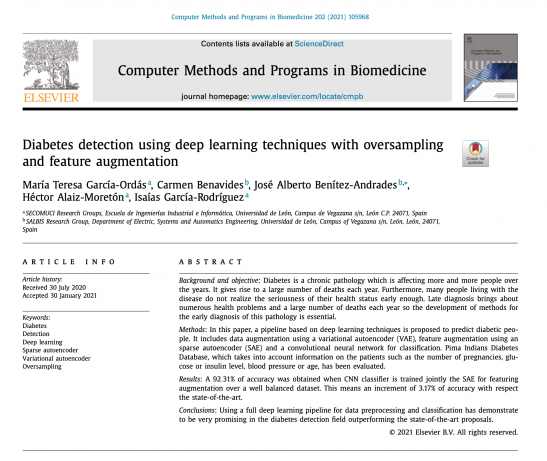Diabetes detection using deep learning techniques with oversampling and feature augmentation
- a SECOMUCI Research Groups, Escuela de Ingenierías Industrial e Informática, Universidad de León, Campus de Vegazana s/n, León C.P. 24071, Spain
- b SALBIS Research Group, Department of Electric, Systems and Automatics Engineering, Universidad de León, Campus of Vegazana s/n, León, León, 24071, Spain
Received 30 July 2020, Accepted 30 January 2021, Available online 15 February 2021.
Highlights
- • A deep learning model has been built to address the prediction of diabetes.
- • Variational auto encoder was trained for sample data augmentation.
- • Sparse auto encoder was trained for feature augmentation.
- • Results obtained demonstrate the powerful of the model using convolutional layers
- • A 92.31% of accuracy was obtained outperforming the state of the art techniques.
Abstract
Background and objective: Diabetes is a chronic pathology which is affecting more and more people over the years. It gives rise to a large number of deaths each year. Furthermore, many people living with the disease do not realize the seriousness of their health status early enough. Late diagnosis brings about numerous health problems and a large number of deaths each year so the development of methods for the early diagnosis of this pathology is essential.
Methods: In this paper, a pipeline based on deep learning techniques is proposed to predict diabetic people. It includes data augmentation using a variational autoencoder (VAE), feature augmentation using an sparse autoencoder (SAE) and a convolutional neural network for classification. Pima Indians Diabetes Database, which takes into account information on the patients such as the number of pregnancies, glucose or insulin level, blood pressure or age, has been evaluated.
Results: A 92.31% of accuracy was obtained when CNN classifier is trained jointly the SAE for featuring augmentation over a well balanced dataset. This means an increment of 3.17% of accuracy with respect the state-of-the-art.
Conclusions: Using a full deep learning pipeline for data preprocessing and classification has demonstrate to be very promising in the diabetes detection field outperforming the state-of-the-art proposals.

